Fig. 10.1
In 2008, three hurricaines struck the island nation of Haiti. The Arbonite region was most severely afffected with the only hospital flooded and unusable. Medecins Sans Frontieres, a humanitarian organization, created a hospital in a warehouse in a few weeks. This hospital had an emergency department, inpatient wards, outpatient clinics and an operating theatre
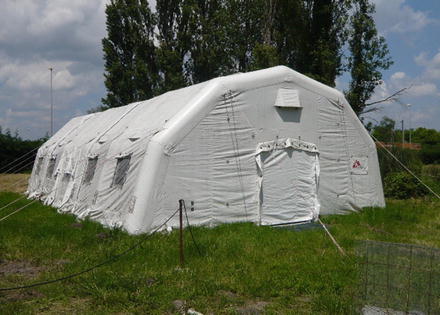
Fig. 10.2
A safe structure is needed for surgery. When a hospital or existing infrastructure is not available, alternatives are needed. Medecins Sans Frontieres has inflatable tents for emergencies which have several departments including emergency, inpatient wards, operating theatres, and even an intensive care unit. These tents have been recently used in the 2010 Haiti earthquake
Electricity
Surgical care requires electricity to power anesthesia machines and surgical equipment such as operating room lighting, electrocautery, and suction. It is also helpful (but not necessary) to sterilize equipment using autoclaves, clean linens, and maintain refrigeration for the cold chain of medications and laboratory reagents. In LMICs, electricity is a precious commodity that is not readily available at all times. Some hospitals use back up generators during electricity shortages. Surgical missions must be prepared for these conditions by purchasing gasoline for host generators, bringing portable lighting, and using surgical and anesthesia equipment that are battery-operated. In response to the lack of reliable power sources in LMICs, many manufacturers have created medical technology that does not rely on electricity. Anesthesia machines with manual ventilators, oxygen compressors/concentrators with battery power capability and portable operating room lights, are just a few examples of equipment available for resource-limited settings [25]. For example, the Universal Anaesthesia Machine, manufactured by Gradian Health Systems, has a manual ventilator and oxygen concentrating mechanism that does not require compressed gases and can function in areas with unreliable power sources [26].
Clean Water
Clean water is needed to provide safe and quality surgical care. Routine hand washing by providers reduces wound infections and cross contamination and the spread of infection [27]. One of the Millennium Development Goals is to halve the number of persons living without drinking water and safe sanitation [28] (Fig. 10.3). The Sphere project, a volunteer initiative for humanitarian agencies has established minimum standards in humanitarian response and recommends 40–60 L of clean water/day/hospitalized patient [29]. For surgical care more is needed and used for cleaning and sterilizing surgical instruments and anesthesia machines, washing linens, and irrigating wounds. MSF recommends 100–300 L/patient/surgical procedure [30]. Sufficient water should be stored on the premises to ensure a steady and uninterrupted supply. If clean water is not available then water and sanitation experts should be a part of the surgical mission to supply or to chlorinate existing sources [31] (see Fig. 10.4).
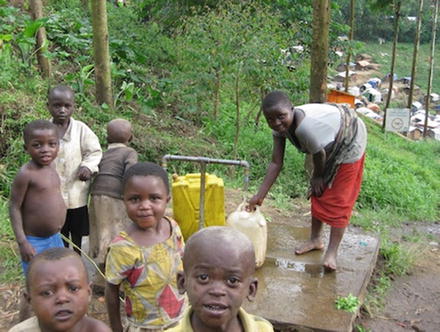
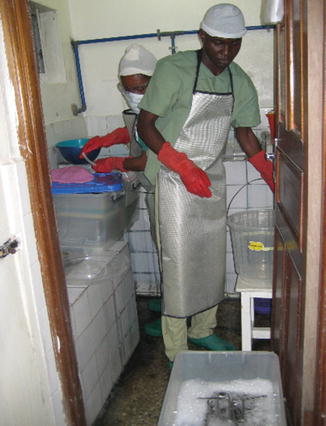

Fig. 10.3
Clean water is an essential right and access is a Millennium Development Goal. An estimated 15–20 L/person/day is needed for personal use and consumption but hospitals need up to 150–200/L/person/day for surgical procedures. Children collecting clean water at a common water point at an internally displaced camp, Masisi, Democratic Republic of Congo

Fig. 10.4
Clean water is a minimum standard of care in humanitarian surgery because it is required for sanitation and sterilization. Photo by Pascale Choquenet
Blood Bank
Preoperative, intraoperative, and postoperative hemorrhage can be life threatening. The ability to transfuse a surgical patient with safe blood can save his or her life. In [29] LMICs, national transfusion services rarely exist and regional hospitals must rely on local blood banks with limited resources [32]. Each mission should have a transfusion protocol since blood is a precious commodity and should not be wasted. Elective surgical missions should identify the nearest blood bank. Emergency missions may have to set up their own system.
Organization should be aware that, at the minimum, blood banks must perform ABO typing and screening for human immunodeficiency virus (HIV), hepatitis B, hepatitis C, and syphilis [33]. Often the ability to store more than a few units of blood is limited by storage capacity and electricity. A list of prescreened potential donors with known blood types can be maintained especially for elective surgical procedures. If an effective blood cold chain does not exist, the transfusion of fresh, whole blood should be used [34]. More details on how to set up a blood bank can be found in the WHO manual, Blood Cold Chain [34].
Campaigns for voluntary unpaid donors are the ideal and safest way to maintain a blood bank; however, during short-term medical missions this can be both costly and time-consuming [33]. When relying on family replacement donors for whole blood during humanitarian surgical missions, the real risk of not transfusing must be weighed against the risk to the patient of contracting a transfusion transmitted illness (TTI) from an unscreened family member and the risk (or perceived risk) to the family member of contracting a TTI from the implements of blood collection [35]. Because of the complexities of providing safe banked or donated blood in a low resource setting, a protocol for blood conservation, intraoperative normothermia, and, if possible, pretreatment of existing anemia should also be in place for any surgical mission.
Sterilization Equipment
In order to safely perform surgery in any setting, sterilization equipment is needed. Simple autoclaves can be powered by wood burning, gas, or electricity and sterilize surgical equipment through high pressure steam at 121 °C for approximately 15–20 min. MSF uses several different models some pictured here (see Fig. 10.5).
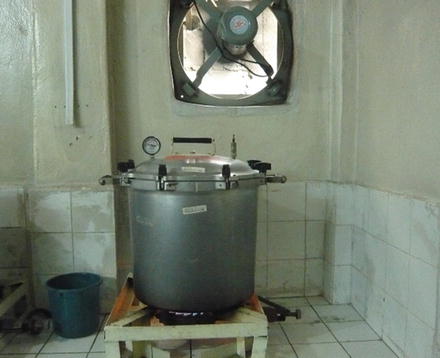
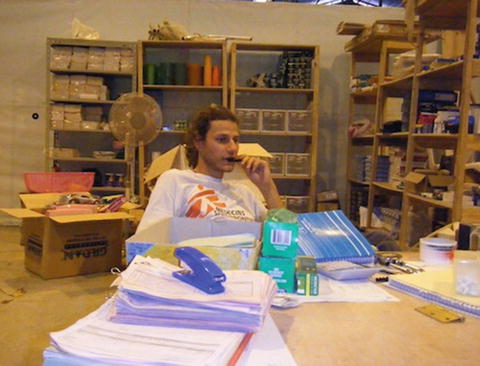

Fig. 10.5
Proper sterilization is a minimum standard for care for all surgical missions. Autoclaves can be small and basic like this 39 L wood burning one, which does not need electricity. Photo used with permission from Pascale Choquenet

Fig. 10.6
A pharmacy that stocks essential medications such as anesthetic agents, antibiotics, and analgesics is needed in any surgical mission. If the local hospital does not have one, this must be created. Importing medications, even for humanitarian use, must be cleared with the appropriate authorities ahead of time
Pharmaceutical Agents
Depending on the surgery general, regional, or local anesthetic agents and analgesics are required. For general anesthesia, inhaled anesthetics such as halothane, isoflurane, and sevoflurane may be used in functional anesthesia machines with vaporizers based on availability of agents and equipment. If these are not available, total intravenous anesthesia can be provided with anesthetics such as propofol, ketamine, thiopental, opioids, and benzodiazepenes [36]. In limited resource areas that do not have reliable oxygen supplies, regional and neuraxial anesthesia with local anesthetics may help to limit alterations in baseline patient physiology [37]. When providing any type of anesthesia care, access to resuscitation medications such as vasopressors, chronotropes, and ionotropes is imperative. Antibiotics covering a broad spectrum of gram-positive, gram-negative, and anaerobic organisms are needed for perioperative treatment and prophylaxis. If these basic medications are not available in the LMIC hospital where the surgical mission is to take place, then they must be brought in or sourced and managed on site (see Fig. 6). When considering medications needed for a medical mission, the WHO Model Lists of Essential Medicines are useful guides that can be tailored based on the clinical conditions and cases anticipated [38].
Anesthesia Monitoring and Equipment
The use of pulse oximetry for intraoperative monitoring saves lives. It is recommended as a minimum standard of monitoring by the WHO, yet over 70,000 operating rooms worldwide lack this essential equipment [39]. The WHO Patient Safety Pulse Oximetry Project aims to improve the safety of surgical care by training surgical providers how to use pulse oximeters [40] and works with organizations like Lifebox who donate pulse oximeters to LMIC hospitals that do not have them [41]. Although pulse oximetry fulfills the minimum standard for anesthesia monitoring, a noninvasive blood pressure cuff and thermometer can be helpful for preoperative assessment as well as intraoperative and postoperative monitoring. Anesthesia care should always be provided under the supervision and vigilance of a trained professional assigned to the care of each surgical patient [42].
In emergency surgery, general anesthesia is often the appropriate anesthetic technique. Certain equipment and monitoring are needed to safely anesthetize patients. Airway management requires both oxygenation and ventilation. Oxygen sources include wall supplies, oxygen cylinders or oxygen compressors. Positive pressure ventilation can be applied with a bag valve mask with positive end expiratory pressure (PEEP) valve or with a ventilator. In preparation for medical missions, anesthesia providers should carry functional laryngoscopes and endotracheal tubes in a variety of sizes, supraglottic airways, oral airways, oro/nasogastric tubes and suction. These supplies allow for the adequate oxygenation and positive-pressure ventilation of a patient while decreasing the risk of aspiration.
In LMIC hospitals, regional and neuraxial anesthesia are invaluable anesthetic techniques. Routine use of regional and neuraxial anesthesia allows providers in low resource settings to avoid many of the economic and hemodynamic pitfalls and challenges that exist with routine use of general anesthesia [43, 44]. Spinal anesthesia can be used for a variety of lower extremity, pelvic, and abdominal surgeries particularly when oxygen is in limited supply. Regional anesthesia with the use of portable ultrasonography or nerve stimulation can provide adequate operative anesthesia, as well as postoperative analgesia for patients in hospitals with limited access to analgesic medications or limited postoperative patient monitoring [45, 46]. It is important to say that the rescue airway equipment mentioned above should always available in case of complications such as caudal spread of a neuraxial anesthetic or local anesthetic toxicity.
Postoperative Recovery Unit (PACU)
The immediate postoperative period can be a dangerous time if hypotension, hypoxia, hypercarbia, or ischemic events occur in unmonitored patients. If these life-threatening conditions are not accurately and quickly identified, they cannot be treated appropriately and death may follow quickly. Some LMIC hospitals do not have enough physical or human resources to have a dedicated PACU and patients are sent back to the postoperative surgical ward immediately after a procedure. This practice is especially risky after general anesthesia or in the face of respiratory or cardiac disease. Humanitarian surgeons should ensure a PACU exists at the hospital they are using, else one must be established. Experienced PACU nurses need to be part of the team if the pre-trip assessment shows a lack of qualified local personnel.
Qualified Surgical and Anesthesia Providers
One of the main reasons the unmet burden of surgical disease in LMICs is so great is the lack of surgical providers [47]. Surgical providers include all personnel involved in the delivery of surgical care including surgeons, anesthesiologists, PACU and surgical ward nurses. HIC surgical providers can play an important role in reducing the LMIC surgical burden through surgical missions. However, they should only provide care (including performing surgery and administering anesthesia) in LMIC for which they are qualified. If a surgeon cannot perform an amputation safely in the USA, then s/he should not be allowed to perform that operation other countries. If an anesthesia provider has not practiced pediatric cardiac anesthesiology since fellowship, s/he should not be allowed to do so during a mission.
Unfortunately, some surgical missions have given humanitarian surgery a bad reputation by adopting the attitude that LMIC patients can be “practiced upon” or that “any care is better than no care” [48, 49]. Surgical and anesthesia residents should not be allowed to operate or provide anesthesia without appropriate supervision regardless of the setting. Currently, no specific credentials are needed for HIC surgeons and anesthesiologists to work in surgical missions. Studies in high-income countries have shown that surgical quality is directly related to surgeon experience [50–53]. Surgeons and anesthesiologists planning to go on elective or emergency missions should receive special training to be better prepared for working in resource-limited settings. MSF and the International Committee for the Red Cross provide additional trauma training for their surgeons to work in war zones.
Processes of Care
The most important measure shown to improve quality of care is adherence to processes of care [3]. Basic protocols such as administration of perioperative antibiotics, the use of pulse oximetry for intraoperative monitoring, and checklists are processes than can be established on surgical missions. This might require pre-trip training of team members or on site training at the beginning of the mission with local staff.
Perioperative Antibiotic Protocols
Appropriate use of prophylactic antibiotics reduces postoperative infections [54]. Some patients will also need a course of postoperative antibiotics especially for contaminated conditions. Antibiotic protocols for common procedures, such as single dose prophylaxis for Cesarean sections can greatly reduce wound infections and endometritis [55]. Surgical missions should establish protocols for the procedures they perform. Antibiotic regimens may have to be adapted for the LMIC setting as there will be fewer choices of agents, but evidence based medicine should be practiced in humanitarian surgery just as pertains in HIC settings.
Checklists
Checklists save lives by standardizing basic safety checks and preparation for complex tasks. The airline industry has demonstrated this unequivocally with pre-flight checklists [56]. Checklists improve surgical quality by changing the culture of practice and ensuring that processes of care are followed [57]. In 2009, WHO published a 19-item surgical checklist that reduces morbidity and mortality in HIC and LMIC [58]. This checklist can be modified for each setting; its main purpose is to ensure that processes of care are adhered to for each individual patient. An adaptation of this surgical safety checklist for humanitarian surgery is shown in, Table 10.1 [1].
Table 10.1
Surgical checklist adapted for humanitarian surgery (adapted with permission from World Journal of Surgery, Chu [1])
1. Perform anesthesia pre-operative evaluation |
2. Pulse oximetry is available and working |
3. Procedure explained to patient and written consent signed |
4. Confirm patient identification |
5. Mark operative site |
6. If significant fluid/blood loss expected, obtain appropriate intravenous access and ensure availability of fluid/blood products |
7. The appropriate surgical instruments are available to perform procedure |
8. Antibiotics have been given if wound is/expected to be contaminated |
9. Postanesthesia care is available |
10. Postoperative care protocol is established |
11. In a mass casualty, the procedure performed, date of dressing change or re-intervention are written on the bandage |
12. Patient and surgical data entered into a database |
Checklists can greatly benefit surgical missions by improving communication between team members from different institutions and local and international providers who speak different primary languages.

Full access? Get Clinical Tree






